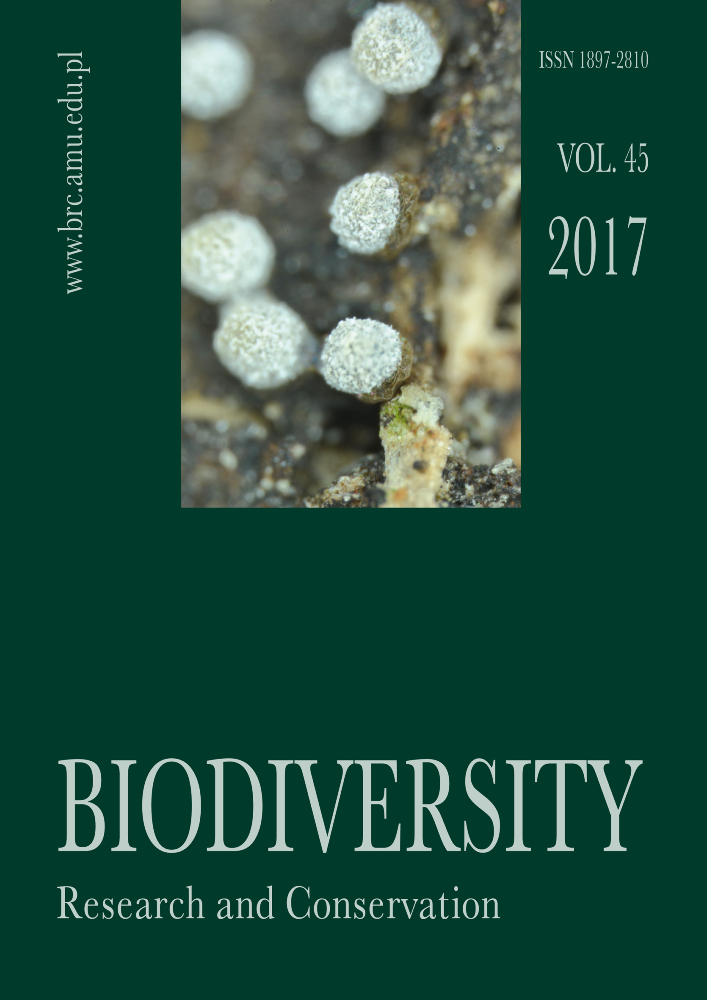Abstract
The paper presents a new Polish record of Badhamia versicolor, a nationally rare and red-listed species of Myxomycetes. It was discovered on the edge of the disused sand and gravel pit (formerly, a gravel mine of the Polish State Railway) in the town of Suwałki, north-eastern Poland. Two small clusters of mature fruiting bodies of B. versicolor were noticed on a bark of living poplar (unidentified species of Populus) and on a fallen leaf of the same poplar tree. Photographic documentation of specimens collected from a new locality is provided.
References
Abdel-Azeem A. M. & Salem Fatma M. 2013. A checklist of Egyptian fungi: I. Protozoan fungal analogues. Mycosphere 4: 794-807.
Drozdowicz A., Ronikier A., Stojanowska W. & Panek E. 2003. Myxomycetes of Poland. A checklist. In: Z. M irek (ed.). Biodiversity of Poland, 10, 103 pp. W. Szafer Institute of Botany, Polish Academy of Sciences, Kraków.
Drozdowicz A., Ronikier A. & Stojanowska W. 2006. Red list of rare Myxomycetes in Poland. In: Z. Mirek, K. Zarzycki, W. Wojewoda & Z. Szeląg (eds.). Red list of plants and fungi in Poland, pp. 91-99. W. Szafer Institute of Botany, Polish Academy of Sciences, Kraków.
Estrada-Torres A ., Wrigley de Basanta D ., Conde E . & Lado C. 2009. Myxomycetes associated with dryland ecosystems of the Tehuacán-Cuicatlán Valley Biosphere Reserve, Mexico. Fungal Divers. 36: 17-56.
Hatano T. & Keller H. W. 2008. A SEM study of genus Badhamia (Myxomycetes). Bull. Shitennoji Univ. 46: 303-314.
Ing B. (ed.). 1982. Provisional atlas of the Myxomycetes of the British Isles. 100 pp. Biological Records Centre, Institute of Terrestrial Ecology, Monks Wood Experimental Station, Huntingdon.
Krzemieniewska H. 1960. Śluzowce Polski na tle śluzowców europejskich. 313 pp. PWN, Warszawa.
Lado C. 1991. Catálogo comentado y síntesis corológica de los Myxomycetes de la Península Ibérica e Islas Baleares (1788-1990). Ruizia 9: 1-142.
Macbride T. H. 1922. The North American slime-moulds, a descriptive list of all species of Myxomycetes hithertoreported from the continent of North America with notes on some extra-limited species. 382 pp. The Macmilian Company, New York, London.
Moreno G ., Castillo A . & Deschamps J. R. 2013. Critical revision of myxomycetes in the Buenos Aires BAFC herbarium - 1. Mycotaxon 123: 63-79.
Panek E . & Romański M. 2010. Śluzowce Myxomycetes. In: L. Krzysztofiak (ed.). Śluzowce Myxomycetes, grzyby Fungi i mszaki Bryophyta Wigierskiego Parku Narodowego, pp. 9-85. Stowarzyszenie “Człowiek i Przyroda”, Suwałki.
Poulain M., Meyer M. & Bozonnet J. 2011. Les Myxomycètes 1. Guide de détermination. 568 pp. Fédération mycologique et botanique Dauphiné-Savoie, Sévrier.
Raciborski M. 1884. Śluzowce (Myxomycetes) Krakowa i jego okolicy. Kosmos, Ser. A, Biol. 18: 3-11.
Ranade V. D ., Korade S. T ., Jagtap A . V. & Ranadive K. R. 2012. Checklist of Myxomycetes from India. Mycosphere 3: 358-390.
Wellman P. 2015. Myxomycetes (slime moulds) of arid to semi-arid areas of northwest New South Wales, Australia. Cunninghamia 15: 153-162.
Wrigley de Basanta D. 1998. Myxomycetes from the bark of the evergreen oak Quercus ilex. Anales Jard. Bot. Madrid 56: 3-14.




